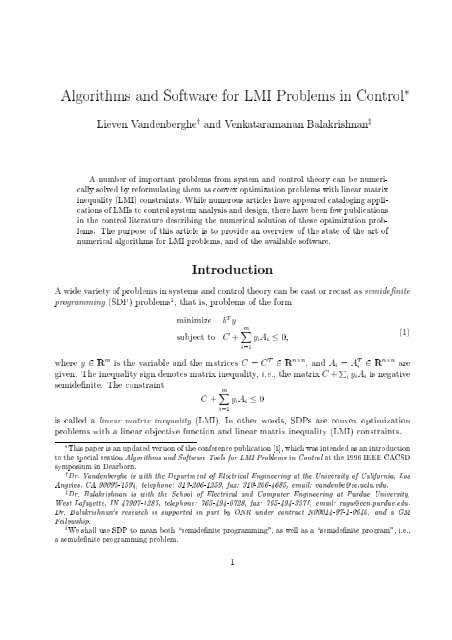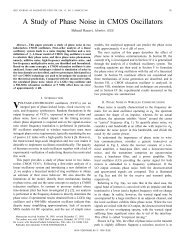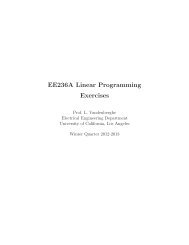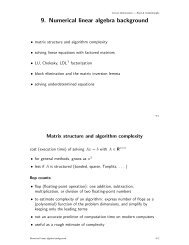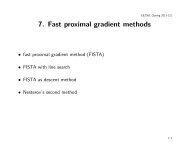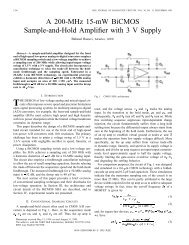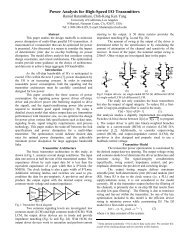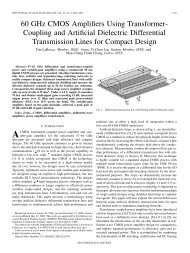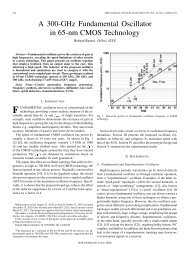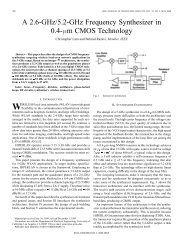Algorithms and Software for LMI Problems in Control Introduction
Algorithms and Software for LMI Problems in Control Introduction
Algorithms and Software for LMI Problems in Control Introduction
Create successful ePaper yourself
Turn your PDF publications into a flip-book with our unique Google optimized e-Paper software.
<strong>Algorithms</strong><strong>and</strong><strong>Software</strong><strong>for</strong><strong>LMI</strong><strong>Problems</strong><strong>in</strong><strong>Control</strong> LievenV<strong>and</strong>enberghey<strong>and</strong>VenkataramananBalakrishnanz<br />
callysolvedbyre<strong>for</strong>mulat<strong>in</strong>gthemasconvexoptimizationproblemswithl<strong>in</strong>earmatrixcationsof<strong>LMI</strong>stocontrolsystemanalysis<strong>and</strong>design,therehavebeenfewpublications<strong>in</strong>equality(<strong>LMI</strong>)constra<strong>in</strong>ts.Whilenumerousarticleshaveappearedcatalog<strong>in</strong>gappliAnumberofimportantproblemsfromsystem<strong>and</strong>controltheorycanbenumeri<strong>in</strong>thecontrolliteraturedescrib<strong>in</strong>gthenumericalsolutionoftheseoptimizationprob- numericalalgorithms<strong>for</strong><strong>LMI</strong>problems,<strong>and</strong>oftheavailablesoftware. lems.Thepurposeofthisarticleistoprovideanoverviewofthestateoftheartof<br />
Awidevarietyofproblems<strong>in</strong>systems<strong>and</strong>controltheorycanbecastorrecastassemidenite programm<strong>in</strong>g(SDP)problems1,thatis,problemsofthe<strong>for</strong>m <strong>Introduction</strong><br />
m<strong>in</strong>imizebTy<br />
wherey2Rmisthevariable<strong>and</strong>thematricesC=CT2Rnn,<strong>and</strong>Ai=ATi2Rnnare subjecttoC+mXi=1yiAi 0; (1)<br />
given.The<strong>in</strong>equalitysigndenotesmatrix<strong>in</strong>equality,i.e.,thematrixC+PiyiAiisnegative<br />
iscalledal<strong>in</strong>earmatrix<strong>in</strong>equality(<strong>LMI</strong>).Inotherwords,SDPsareconvexoptimization semidenite.Theconstra<strong>in</strong>t<br />
problemswithal<strong>in</strong>earobjectivefunction<strong>and</strong>l<strong>in</strong>earmatrix<strong>in</strong>equality(<strong>LMI</strong>)constra<strong>in</strong>ts. C+mXi=1yiAi 0<br />
tothespecialsession<strong>Algorithms</strong><strong>and</strong><strong>Software</strong>Tools<strong>for</strong><strong>LMI</strong><strong>Problems</strong><strong>in</strong><strong>Control</strong>atthe1996IEEECACSD symposium<strong>in</strong>Dearborn. Angeles,CA90095-1594,telephone:310-206-1259,fax:310-206-4685,email:v<strong>and</strong>enbe@ee.ucla.edu. yDr.V<strong>and</strong>enbergheiswiththeDepartmentofElectricalEng<strong>in</strong>eer<strong>in</strong>gattheUniversityofCali<strong>for</strong>nia,Los Thispaperisanupdatedversionoftheconferencepublication[1],whichwas<strong>in</strong>tendedasan<strong>in</strong>troduction<br />
WestLafayette,IN47907-1285,telephone:765-494-0728,fax:765-494-3371,email:ragu@ecn.purdue.edu. Fellowship. Dr.Balakrishnan'sresearchissupported<strong>in</strong>partbyONRundercontractN00014-97-1-0640,<strong>and</strong>aGM 1WeshalluseSDPtomeanboth\semideniteprogramm<strong>in</strong>g",aswellasa\semideniteprogram",i.e.,<br />
zDr.BalakrishnaniswiththeSchoolofElectrical<strong>and</strong>ComputerEng<strong>in</strong>eer<strong>in</strong>gatPurdueUniversity,<br />
asemideniteprogramm<strong>in</strong>gproblem. 1
encountered<strong>in</strong>systems<strong>and</strong>controltheory.Examples<strong>in</strong>clude:multicriterionLQG,synthesis state-spacerealizationsoftransfermatrices,normscal<strong>in</strong>g,synthesisofmultipliers<strong>for</strong>Popov- ofl<strong>in</strong>earstatefeedback<strong>for</strong>multipleornonl<strong>in</strong>earplants(\multi-modelcontrol"),optimal Thoughthe<strong>for</strong>moftheSDP(1)appearsveryspecialized,itturnsoutthatitiswidely<br />
ga<strong>in</strong>-scheduledcontrollerdesign,<strong>and</strong>manyothers. likeanalysisofsystemswithunknownga<strong>in</strong>s,robustnessanalysis<strong>and</strong>robustcontrollerdesign,<br />
canbesolvednumericallyveryeciently.Inmanycases|<strong>for</strong>example,withmulti-model control[3]|the<strong>LMI</strong>sencountered<strong>in</strong>SDPs<strong>in</strong>systems<strong>and</strong>controltheoryhavethe<strong>for</strong>m <strong>for</strong>theonesencounteredwithH2<strong>and</strong>H1control[2],<strong>for</strong>example),but<strong>in</strong>generalthey Forafewveryspecialcasesthereare\analyticalsolutions"toSDPs(viaRiccatiequations<br />
ofsimultaneous(coupled)LyapunovoralgebraicRiccati<strong>in</strong>equalities;us<strong>in</strong>grecent<strong>in</strong>terior-<br />
onthesolutionofalgebraicRiccatiequationstoatheorybasedonthesolutionof(multiple, po<strong>in</strong>tmethodssuchproblemscanbesolved<strong>in</strong>atimethatisroughlycomparabletothetime<br />
simultaneous)LyapunovorRiccati<strong>in</strong>equalitiesismodest. [3,4].There<strong>for</strong>ethecomputationalcostofextend<strong>in</strong>gcurrentcontroltheorythatisbased requiredtosolvethesamenumberof(uncoupled)LyapunovorAlgebraicRiccatiequations<br />
SDPtothesolutionofsystem<strong>and</strong>controlproblems.Perhapsthemostcomprehensivelistcan befound<strong>in</strong>thebook[3].S<strong>in</strong>ceitspublication,anumberofpapershaveappearedchronicl<strong>in</strong>g furtherapplicationsofSDP<strong>in</strong>control;wecite<strong>for</strong><strong>in</strong>stancethesurveyarticle[5]thatappeared Anumberofpublicationscanbefound<strong>in</strong>thecontrolliteraturethatsurveyapplicationsof<br />
<strong>Control</strong>onL<strong>in</strong>earMatrixInequalities<strong>in</strong><strong>Control</strong>Theory<strong>and</strong>Applications,publishedrecently, evidencedbythelargenumberofpublications<strong>in</strong>recentcontrolconferences. <strong>in</strong>November-December,1996[6].Thegrow<strong>in</strong>gpopularityof<strong>LMI</strong>methods<strong>for</strong>controlisalso <strong>in</strong>thismagaz<strong>in</strong>e,<strong>and</strong>thespecialissueoftheInternationalJournalofRobust<strong>and</strong>Nonl<strong>in</strong>ear<br />
certa<strong>in</strong>eigenvaluem<strong>in</strong>imizationproblemsthatcanbecastasSDPshavebeenused<strong>for</strong>obta<strong>in</strong><strong>in</strong>gbounds<strong>and</strong>heuristicsolutions<strong>for</strong>comb<strong>in</strong>atorialoptimizationproblems(see[7,8] <strong>and</strong>[9,Chapter9]).Theeciencyofrecent<strong>in</strong>terior-po<strong>in</strong>tmethods<strong>for</strong>SDP,whichisdirectly SpecialclassesoftheSDPhavealonghistory<strong>in</strong>optimizationaswell.Forexample,<br />
responsible<strong>for</strong>thepopularityofSDP<strong>in</strong>control,hasthere<strong>for</strong>ealsoattractedagreatdealof <strong>in</strong>terest<strong>in</strong>optimizationcircles,overshadow<strong>in</strong>gearliersolutionmethodsbasedontechniques<br />
wasprimarilymotivatedbyapplicationsofSDP<strong>in</strong>comb<strong>in</strong>atorialoptimizationbut,more ference,thereareworkshops<strong>and</strong>specialsessionsdevotedexclusivelytoSDP,<strong>and</strong>aspecial issueofMathematicalProgramm<strong>in</strong>ghasrecentlybeendevotedtoSDP[14].This<strong>in</strong>terest fromnondierentiableoptimization[8,10,11,12,13].Ateverymajoroptimizationcon-<br />
recently,alsobytheapplications<strong>in</strong>control. thedenition<strong>and</strong>somebasicpropertiesofthesemideniteprogramm<strong>in</strong>gproblem.We thendescriberecentdevelopments<strong>in</strong><strong>in</strong>terior-po<strong>in</strong>talgorithms<strong>and</strong>availablesoftware.We ofnumericalalgorithms<strong>for</strong><strong>LMI</strong>problems,<strong>and</strong>oftheavailablesoftware.Werstreview Theprimarypurposeofthisarticleistoprovideanoverviewofthestateoftheart<br />
concludewithsomeextensionsofSDP.<br />
2
Inthissectionweprovideabrief<strong>in</strong>troductiontothesemideniteprogramm<strong>in</strong>gproblem.For moreextensivesurveysonthetheory<strong>and</strong>applicationsofSDP,werefertoAlizadeh[15],Boyd Semideniteprogramm<strong>in</strong>g<br />
etal.[3],Lewis<strong>and</strong>Overton[16],Nesterov<strong>and</strong>Nemirovskii[17,x6.4],<strong>and</strong>V<strong>and</strong>enberghe <strong>and</strong>Boyd[18]. tions,wewillreferto(1)asanSDP<strong>in</strong><strong>in</strong>equality<strong>for</strong>m.TheoptimizationproblemWehavealreadydenedanSDP<strong>for</strong>mally<strong>in</strong>(1).Todist<strong>in</strong>guishitfromother<strong>for</strong>mula- maximizeTrCX<br />
iscalledanSDP<strong>in</strong>equality<strong>for</strong>m.Here,thevariableisthematrixX=XT2Rnn,<strong>and</strong> subjecttoXTrAiX+bi=0;i=1;:::;m 0 (2)<br />
the`st<strong>and</strong>ard'<strong>for</strong>m(althoughthe<strong>in</strong>equality<strong>for</strong>mappearstobemoreappropriate<strong>for</strong>control theory). easilyconverted<strong>in</strong>to(2)<strong>and</strong>vice-versa,soitisamatterofconventionwhatweconsideras Trst<strong>and</strong>s<strong>for</strong>trace,ie.,sumofthediagonalentriesofasquarematrix.TheSDP(1)canbe<br />
eralizationsofseveralimportantoptimizationproblems.Forexample,thel<strong>in</strong>earprogram (LP) Itturnsoutthatthethesemideniteprograms(1)<strong>and</strong>(2)canberegardedasgen- maximizecTx<br />
<strong>in</strong>whichthe<strong>in</strong>equalityxsubjecttox 0denotescomponentwise<strong>in</strong>equality,canbeexpressedasan aTix+bi=0;i=1;:::;m; 0 (3)<br />
orthantisreplacedbytheconeofpositivesemidenitematrices. <strong>in</strong>equalitiesbetweenvectorsarereplacedbymatrix<strong>in</strong>equalities,or,equivalently,therst SDP(2)withAi=diag(ai)<strong>and</strong>C=diag(c),<strong>and</strong>X=diag(x).Semideniteprogramm<strong>in</strong>gcanalsoberegardedasanextensionofl<strong>in</strong>earprogramm<strong>in</strong>gwherethecomponentwise istheoptimalvalueof(2)<strong>and</strong>u?istheoptimalvalueof(1),thenwehave: Itcanbeshownthatproblems(1)<strong>and</strong>(2)aredualsofeachother.Moreprecisely,if`?<br />
strongduality:If(1)isstrictlyfeasible(i.e.,thereexistsaywithC+PiyiAi0withTrAiX+bi=0),then `?;<br />
orythatdoesnotrequirestrictfeasibilitywasrecentlydevelopedbyRamana,Tuncel<strong>and</strong>Theresultfollowsfromst<strong>and</strong>ardconvexoptimizationduality.(Astrongerdualitythe- u?=`?.<br />
<strong>in</strong>[20]. Wolkowicz[19].)SomeconnectionsbetweenSDPduality<strong>and</strong>duality<strong>in</strong>controlareexplored Ifweassumethatboth(1)<strong>and</strong>(2)arestrictlyfeasible,thentheoptimalvalues<strong>in</strong>both<br />
3
problemsareatta<strong>in</strong>ed,<strong>and</strong>thesolutionsarecharacterizedbytheoptimalityconditions TrAiX+bi=0;i=1;:::;m XZ+C+Pmi=1yiAi=0 XZ=0: 0;Z 0<br />
TherstthreeconditionsstatefeasibilityofX,Z<strong>and</strong>y.Thelastconditioniscalled (4)<br />
complementaryslackness.<br />
Briefhistory Interior-po<strong>in</strong>tmethods<br />
method<strong>for</strong>LP[24].In1988Nesterov<strong>and</strong>Nemirovskii[25]showedthatthose<strong>in</strong>terior-po<strong>in</strong>t est<strong>in</strong>themwasrevived<strong>in</strong>1984,whenKarmarkar<strong>in</strong>troducedapolynomial-time<strong>in</strong>terior-po<strong>in</strong>t Theideasunderly<strong>in</strong>g<strong>in</strong>terior-po<strong>in</strong>tmethods<strong>for</strong>convexoptimizationcanbetracedbackto<br />
methods<strong>for</strong>l<strong>in</strong>earprogramm<strong>in</strong>gcan,<strong>in</strong>pr<strong>in</strong>ciple,begeneralizedtoallconvexoptimization thesixties;seee.g.,Fiacco<strong>and</strong>McCormick[21],Lieu<strong>and</strong>Huard[22],<strong>and</strong>Dik<strong>in</strong>[23]).Inter-<br />
there<strong>for</strong>e,<strong>in</strong>terior-po<strong>in</strong>tmethodsareapplicable. ertycalledself-concordance.L<strong>in</strong>earmatrix<strong>in</strong>equalitiesareanimportantclassofconvex constra<strong>in</strong>ts<strong>for</strong>whichreadilycomputableself-concordantbarrierfunctionsareknown,<strong>and</strong>, problems.Thekeyelementistheknowledgeofabarrierfunctionwithacerta<strong>in</strong>prop28]generalized<strong>in</strong>terior-po<strong>in</strong>tmethodsfroml<strong>in</strong>earprogramm<strong>in</strong>gtosemideniteprogram-<br />
methods<strong>for</strong>l<strong>in</strong>earprogramm<strong>in</strong>ghavebeenextendedtosemideniteprogramm<strong>in</strong>g.This m<strong>in</strong>g.Vastprogresshasbeenmade<strong>in</strong>thelasttwoyears,<strong>and</strong>todayalmostall<strong>in</strong>terior-po<strong>in</strong>t IndependentlyofNesterov<strong>and</strong>Nemirovskii,Alizadeh[26]<strong>and</strong>Kamath<strong>and</strong>Karmarkar[27,<br />
theexcellentper<strong>for</strong>manceofprimal-dual<strong>in</strong>terior-po<strong>in</strong>tmethods<strong>for</strong>large-scalel<strong>in</strong>earpro- recentresearchhaslargelyconcentratedonprimal-dualmethods<strong>in</strong>thehopeofemulat<strong>in</strong>g<br />
astheprojectivealgorithm<strong>and</strong>themethodofcenters.Wereferto[5,p.80]or[3,x2]<strong>for</strong> gramm<strong>in</strong>g[29,30].Therema<strong>in</strong>derofthissectionwillconcentrateonthisrecentwork.We<br />
surveysoftheseearliermethods. algorithm,themethodofalternat<strong>in</strong>gprojections,<strong>and</strong>primal<strong>in</strong>terior-po<strong>in</strong>tmethodssuch shouldmentionhoweverthatothermethodshavebeenusedsuccessfully,e.g.,theellipsoid<br />
Primal-dualmethods<strong>for</strong>SDP Themostpromis<strong>in</strong>gmethods<strong>for</strong>semideniteprogramm<strong>in</strong>gsolvethetwoproblems(1) <strong>and</strong>(2)simultaneously.Theseprimal-dualmethodsareusually<strong>in</strong>terpretedasmethods<strong>for</strong> y()ofthenonl<strong>in</strong>earequationsX follow<strong>in</strong>gtheprimal-dualcentralpath,whichisdenedasthesetofsolutionsX(),Z(),<br />
TrAiX+bi=0;i=1;:::;m Z+C+Pmi=1yiAi=0 XZ=I; 0;Z 0 (5)<br />
4
unique<strong>for</strong> complementaryslacknessconditionXZ=0.Itcanbeshownthatthesolutionof(5)is conditions(4).Theonlydierenceisthelastcondition,XZ=I,whichreplacesthe where 0isaparameter.Notethattheseconditionsareverysimilartotheoptimality<br />
X()m<strong>in</strong>imizes approachoptimalityifgoestozero. Thecentralpo<strong>in</strong>tsX(),y(),Z()arealsothem<strong>in</strong>imizersoftwoconvexfunctions: >0(assum<strong>in</strong>gstrictprimal<strong>and</strong>dualfeasibility),<strong>and</strong>thatX(),Z(),y()<br />
overallX>0withTrAiX+bi=0;y()m<strong>in</strong>imizes 'd(;y)=bTy�logdet 'p(;X)=�TrCX�logdetX�1<br />
self-concordant,whichallowsustoapplyNesterov<strong>and</strong>Nemirovskii'stheory<strong>for</strong>prov<strong>in</strong>g overallywithC+Pmi=1yiAi0,Z>0,ybethecurrentiterate.Forsimplicityweassumethatthesepo<strong>in</strong>ts<br />
Z+mXi=1yiAi=0 TrAiX=0;i=1;:::;m<br />
Ifweelim<strong>in</strong>ateZfromthesecond<strong>and</strong>thirdequations,weobta<strong>in</strong> X+Z�1ZZ�1=Z�1�X:<br />
��1ZXZ+mXi=1yiAi=�1ZXZ�Z: TrAiX=0;i=1;:::;m (7) (6)<br />
diag(z),X=diag(x),<strong>and</strong> Thisisasetofm+n(n+1)=2equations<strong>in</strong>them+n(n+1)=2variablesy,X=XT2Rnn. InthespecialcaseoftheLP(3),whereallmatricesarediagonal,wecanwriteZ= " ��1Z2A#"xy#=" AT 0 5<br />
�1Z2x�z#: 0
whereA=[a1:::am]. whichleadsto Asecondpossibility<strong>for</strong>l<strong>in</strong>eariz<strong>in</strong>gtheequationXZ=IistowriteitasZ=X�1,<br />
Z+mXi=1yiAi=0 TrAiX=0;i=1;:::;m<br />
Elim<strong>in</strong>at<strong>in</strong>gZ,weobta<strong>in</strong>X�1XX�1+Z=�Z+X�1: �X�1XX�1+mXi=1yiAi=Z�X�1: TrAiX=0;i=1;:::;m<br />
Specializedtol<strong>in</strong>earprogramm<strong>in</strong>gtheequationsbecome "<br />
TherstSDPmethodswerebasedontheseprimalordualscal<strong>in</strong>gs(see<strong>for</strong>example, �X�2A#"xy#=" AT 0 z�X�1e#: 0<br />
Yoshise[31].Forl<strong>in</strong>earprogramm<strong>in</strong>gtheresult<strong>in</strong>gequations<strong>for</strong>thesearchdirectionshave oneusuallyprefersaprimal-dualsymmetricscal<strong>in</strong>g<strong>in</strong>troducedbyKojima,Mizuno<strong>and</strong> programm<strong>in</strong>g,however,theprimal<strong>and</strong>dualscal<strong>in</strong>gsarerarelyused<strong>in</strong>practice.Instead, Nesterov<strong>and</strong>Nemirovskii[17],Alizadeh[26],<strong>and</strong>V<strong>and</strong>enberghe<strong>and</strong>Boyd[4]).Inl<strong>in</strong>ear<br />
the<strong>for</strong>m Theseequationsareobta<strong>in</strong>edbyl<strong>in</strong>eariz<strong>in</strong>gXZ=Ias " �X�1ZA#"xy#=" AT 0 z�X�1e:#: 0 (8)<br />
scal<strong>in</strong>gcanachieveahigheraccuracythanmethodsbasedonthetheprimalordualscal<strong>in</strong>g Severalresearchershavedemonstratedthatmethodsthatusethisprimal-dualsymmetric XZ+XZ=I�XZ: (9)<br />
(see<strong>for</strong>exampleWright[32]),<strong>and</strong>there<strong>for</strong>ethesymmetricscal<strong>in</strong>gisthebasisofallpractical LP<strong>in</strong>terior-po<strong>in</strong>tmethods. l<strong>in</strong>earization(9)leadstoal<strong>in</strong>earsystemTrAiX=0;i=1;:::;m Theextensionofthissymmetricprimal-dualscal<strong>in</strong>gtoSDPisnotstraight<strong>for</strong>ward:The<br />
�X�1XZ+mXi=1yiAi=Z�X�1 (11) (10)<br />
research<strong>in</strong>SDPhasthere<strong>for</strong>econcentratedonextend<strong>in</strong>gtheprimal-dualsymmetricscal<strong>in</strong>g butun<strong>for</strong>tunatelythesolutionXisnotsymmetric<strong>in</strong>general.Muchofthemostrecent 6
seemtobethemostpromis<strong>in</strong>g.Helmberg,Rendl,V<strong>and</strong>erbei,<strong>and</strong>Wolkowicz[33],Kojima, Shidoh<strong>and</strong>Hara[34],<strong>and</strong>Monteiro[35]solve(10)<strong>and</strong>(11)<strong>and</strong>l<strong>in</strong>earizetheresult<strong>in</strong>gX. lasttwoyears.Amongtheproposedsymmetricprimal-dualalgorithms,threevariations fromLPtoSDP,<strong>and</strong>,asaresultofthiseort,veryrapidprogresshasbeenmade<strong>in</strong>the<br />
Alizadeh,Haeberly<strong>and</strong>Overton[36]rstwriteXZ=IasXZ+ZX=2I<strong>and</strong>then<br />
<strong>and</strong>recentlySturm<strong>and</strong>Zhang[39],havedenedathirddirection,obta<strong>in</strong>edasfollows.First Theresult<strong>in</strong>gX<strong>and</strong>Zareautomaticallysymmetric.F<strong>in</strong>ally,Nesterov<strong>and</strong>Todd[37,38], l<strong>in</strong>earizethisas<br />
amatrixRiscomputedsuchthatRTXR=1=2<strong>and</strong>RTZ�1R=1=2,whereisadiagonal XZ+XZ+ZX+ZX=2I�XZ�ZX:<br />
matrixwithasdiagonalelementstheeigenvaluesofXZ.Onethensolvestheequations �RRTXRRT+mXi=1yiAi=Z�X�1: TrAiX=0;i=1;:::;m (13) (12)<br />
toobta<strong>in</strong>thesearchdirectionsX,Z,y.Numericaldetailsonthismethodcanbefound <strong>in</strong>Todd,Toh<strong>and</strong>Tutuncu[40].F<strong>in</strong>ally,Kojima,Sh<strong>in</strong>doh<strong>and</strong>Hara[34],Monteiro[35],<strong>and</strong> Monteiro<strong>and</strong>Zhang[41]havepresentedunify<strong>in</strong>gframeworks<strong>for</strong>primal-dualmethods.<br />
<strong>Software</strong>packages Someotherimportantrecentarticles<strong>and</strong>reportsarelisted<strong>in</strong>thereferencesofthispaper2.<br />
implementationofan<strong>in</strong>terior-po<strong>in</strong>tmethod<strong>for</strong>SDPwasbyNesterov<strong>and</strong>Nemirovskii<strong>in</strong> [65],us<strong>in</strong>gtheprojectivealgorithm[17].Matlab's<strong>LMI</strong><strong>Control</strong>Toolbox[66]isbasedon Severalresearchershavemadeavailablesoftware<strong>for</strong>semideniteprogramm<strong>in</strong>g.Therst thesamealgorithm,<strong>and</strong>oersagraphicaluser<strong>in</strong>terface<strong>and</strong>extensivesupport<strong>for</strong>control applications.ThecodeSP[67]isbasedonaprimal-dualpotentialreductionmethodwith theNesterov<strong>and</strong>Toddscal<strong>in</strong>g.Thecodeiswritten<strong>in</strong>CwithcallstoBLAS<strong>and</strong>LAPACK <strong>in</strong>terfacestoSPthatsimplifythespecicationofSDPswherethevariableshavematrix <strong>and</strong><strong>in</strong>cludesan<strong>in</strong>terfacetoMatlab.SDPSOL[68]<strong>and</strong><strong>LMI</strong>TOOL[69]oeruser-friendly structure.TheInduced-Norm<strong>Control</strong>Toolbox[70]isatoolbox<strong>for</strong>robust<strong>and</strong>optimal control,<strong>in</strong>turnbasedon<strong>LMI</strong>TOOL.<br />
Wolkowicz[33].SDPHA[73]isaMatlabimplementationofahomogeneous<strong>for</strong>mulationof CSDP[72]isaCimplementationofthealgorithmofHelmberg,Rendl,V<strong>and</strong>erbei,<strong>and</strong> SDPA[71]isaC++code,basedonthealgorithmofKojima,Sh<strong>in</strong>doh<strong>and</strong>Hara[34]. Severalimplementationsofthemostrecentprimal-dualmethodsarealsoavailablenow.<br />
thedierentprimal-dualmethodsdescribedabove.SDPT3[74]isaMatlabimplementation<br />
l<strong>in</strong>earconstra<strong>in</strong>tsdirectly. ofthemostimportant<strong>in</strong>feasibleprimal-dualpath-follow<strong>in</strong>gmethods.SDPPACK[75]isan <strong>in</strong>Cto<strong>in</strong>creasetheeciency.Italsoprovidestheusefulfeatureofh<strong>and</strong>l<strong>in</strong>gquadratic<strong>and</strong> implementationofthealgorithmof[36].Itiswritten<strong>in</strong>Matlab,withcriticalpartswritten<br />
gonneNationalLaboratory(http://www.mcs.anl.gov/home/otc/InteriorPo<strong>in</strong>t/<strong>in</strong>dex.html).Helmberg(http://www.zib-berl<strong>in</strong>.de/~bzfhelmb/semidef.html)<strong>and</strong>the<strong>in</strong>terior-po<strong>in</strong>tarchiveatAr- 2Mostrecentpapersareavailableatthesemideniteprogramm<strong>in</strong>ghomepagema<strong>in</strong>ta<strong>in</strong>edbyCristoph<br />
7
Thedeterm<strong>in</strong>antmaximizationproblem Extensions<br />
thefollow<strong>in</strong>g<strong>for</strong>m: theSDP(1),whichwasdiscussed<strong>in</strong>moredetail<strong>in</strong>[76].Thisextensioncanbewritten<strong>in</strong> Intheirsurveyof<strong>LMI</strong>problems<strong>in</strong>control,Boydetal.[3]alsoconsideredanextensionof<br />
m<strong>in</strong>imizebTy�logdet subjecttoC+mXi=1yiAi �D�mXi=1yiBi!<br />
D+mXi=1yiBi0 (15)<br />
<strong>in</strong><strong>for</strong>mation<strong>and</strong>communicationtheory.There<strong>for</strong>ethetheorybeh<strong>in</strong>dtheirsolutionisof <strong>and</strong>(14)areduals.<br />
an<strong>in</strong>terior-po<strong>in</strong>tmethod<strong>for</strong>themaxdet-problemaredescribed<strong>in</strong>[76].<strong>Software</strong><strong>for</strong>solv<strong>in</strong>g great<strong>in</strong>terest,<strong>and</strong>theresult<strong>in</strong>galgorithmshavewideapplication.Alistofapplications<strong>and</strong> Maxdet-problemsarise<strong>in</strong>manyelds,<strong>in</strong>clud<strong>in</strong>gcomputationalgeometry,statistics,<strong>and</strong><br />
maxdet-problemsisavailable<strong>in</strong>[77],<strong>and</strong>hasbeen<strong>in</strong>corporated<strong>in</strong>SDPSOL[68]. Thegeneralizedeigenvaluem<strong>in</strong>imizationproblem<br />
theirmaximumgeneralizedeigenvalue,wecansolvetheoptimizationproblem posewehaveapairofmatrices(A(x);B(x)),bothanefunctionsofx.Inordertom<strong>in</strong>imizeAthirdst<strong>and</strong>ardproblemfrom[3]isthegeneralizedeigenvaluem<strong>in</strong>imizationproblem.Sup- m<strong>in</strong>imizet<br />
3TheproblemwasdenotedCP<strong>in</strong>[3]. subjecttotB(x)�A(x) B(x) 0: 0 (16)<br />
8
Thisiscalledageneralizedl<strong>in</strong>ear-fractionalproblem.It<strong>in</strong>cludesthel<strong>in</strong>earfractionalproblem<br />
subjecttoAx+b m<strong>in</strong>imize eTx+f cTx+d<br />
asaspecialcase. Problem(16)isnotasemideniteprogram,however,becauseofthebil<strong>in</strong>eartermtB(x). 0;eTx+f>0<br />
Itisaquasi-convexproblem,<strong>and</strong>canstillbeecientlysolved.SeeBoyd<strong>and</strong>ElGhaoui[78], izedalgorithms,<strong>and</strong>[3]<strong>for</strong>applicationsofthisproblem<strong>in</strong>control.AnimplementationofHaeberly<strong>and</strong>Overton[79],<strong>and</strong>Nesterov<strong>and</strong>Nemirovskii[17,80,81]<strong>for</strong>detailsonspecial- theNesterov<strong>and</strong>Nemirovskiialgorithmisalsoprovided<strong>in</strong>the<strong>LMI</strong><strong>Control</strong>toolbox[66].<br />
WenallyconsideranextensionoftheSDP(1),obta<strong>in</strong>edbyreplac<strong>in</strong>gthel<strong>in</strong>earmatrix Thebil<strong>in</strong>earmatrix<strong>in</strong>equalityproblem <strong>in</strong>equalityconstra<strong>in</strong>tsbyaquadraticmatrix<strong>in</strong>equality, m<strong>in</strong>imizebTy<br />
Thisproblemisnonconvex,butitisextremelygeneral.Forexample,ifthematricesC,Ai, subjecttoC+mXi=1yiAi+mX i;j=1yiyjBij 0: (17)<br />
<strong>and</strong>Bijarediagonal,theconstra<strong>in</strong>t<strong>in</strong>(17)reducestoasetofn(possibly<strong>in</strong>denite)quadratic constra<strong>in</strong>ts<strong>in</strong>x.Problem(17)there<strong>for</strong>e<strong>in</strong>cludesallquadraticoptimizationproblems.It also<strong>in</strong>cludesallpolynomialproblems(s<strong>in</strong>ceby<strong>in</strong>troduc<strong>in</strong>gnewvariables,onecanreduce<br />
wesplitthevariables<strong>in</strong>twovectorsx<strong>and</strong>y,<strong>and</strong>replacetheconstra<strong>in</strong>tbyabil<strong>in</strong>ear(or etc.Incontroltheory,amorerestrictedbil<strong>in</strong>ear<strong>for</strong>mseemstobegeneralenough.Here anypolynomial<strong>in</strong>equalitytoasetofquadratic<strong>in</strong>equalities),allf0;1g<strong>and</strong><strong>in</strong>tegerprograms,<br />
bi-ane)matrix<strong>in</strong>equality(BMI): m<strong>in</strong>imizecTx+bTy<br />
Theproblemdataarethevectorsc2Rm<strong>and</strong>b2Rl<strong>and</strong>thesymmetricmatricesAi,Bk, subjecttoD+mXi=1yiAi+lXk=1xkBk+mXi=1lXk=1xiykCik 0: (18)<br />
<strong>and</strong>Cik2Rnn.<br />
mentaldierencewith<strong>LMI</strong>sisthatBMIproblemsarenon-convex,<strong>and</strong>nonon-exponentialGoh,<strong>and</strong>others[82,83,84,85,86,87],ElGhaoui<strong>and</strong>Balakrishnan[88],etc).Thefundacerta<strong>in</strong>ty,xed-ordercontrollerdesign,decentralizedcontrollersynthesisetc.(seeSafonov,BMIs<strong>in</strong>cludeawidevarietyofcontrolproblems,<strong>in</strong>clud<strong>in</strong>gsynthesiswithstructuredun- referencesareeitherlocalmethodsthatalternatebetweenm<strong>in</strong>imiz<strong>in</strong>goverx<strong>and</strong>y,orglobal timealgorithms<strong>for</strong>theirsolutionareknowntoexist.Thealgorithmsdescribed<strong>in</strong>theabove (branch<strong>and</strong>bound)techniquesbasedonthesolutionofasequenceof<strong>LMI</strong>problems. 9
Thecurrentstateofresearchon<strong>LMI</strong>s<strong>in</strong>controlcanbesummarized: Conclusion<br />
thelattercase,bil<strong>in</strong>earmatrix<strong>in</strong>equalities(BMIs)havebeenrecognizedasauseful <strong>in</strong>termsof<strong>LMI</strong>s,<strong>and</strong>those<strong>for</strong>whichan<strong>LMI</strong><strong>for</strong>mulationisunlikelytoexist.In Therehasbeen<strong>in</strong>tensiveresearchonidentify<strong>in</strong>gcontrolproblemsthatcanbecast<br />
rapidprogress<strong>in</strong><strong>in</strong>terior-po<strong>in</strong>talgorithms<strong>for</strong>solv<strong>in</strong>gSDPs,focus<strong>in</strong>gonlocalconver- <strong>for</strong>mulation.<br />
gencerates,worst-casecomplexity,etc.,<strong>and</strong>onextend<strong>in</strong>gtoSDPthesophisticated Thecomb<strong>in</strong>edactivity<strong>in</strong>mathematicalprogramm<strong>in</strong>g<strong>and</strong>controltheoryhasledtovery <strong>and</strong>ecientprimal-dual<strong>in</strong>terior-po<strong>in</strong>tmethodsdeveloped<strong>for</strong>l<strong>in</strong>earprogramm<strong>in</strong>g.<br />
Thus<strong>LMI</strong>sarebecom<strong>in</strong>gbasictools<strong>in</strong>control,muchthewayRiccatiequationsbecame available.Thesecodeshaveprovenuseful<strong>for</strong>smalltomedium-sizedproblems. Severalbasicsoftwareimplementationsof<strong>in</strong>terior-po<strong>in</strong>tmethods<strong>for</strong>SDPhavebecome<br />
problemsthatarise<strong>in</strong>control.Weexpectthatthisresearchwillleadtoasecondgeneration ofgeneral-purpose<strong>LMI</strong>codes,whichwillexploitmoreproblemstructure(e.g.,sparsity)to calprogramm<strong>in</strong>gcommunityislead<strong>in</strong>gtomorepowerfulalgorithms<strong>for</strong>the<strong>LMI</strong><strong>and</strong>BMIbasictools<strong>in</strong>the1960s.Atthesametime,thecurrentstrong<strong>in</strong>terest<strong>in</strong>themathematipurposesoftware<strong>for</strong>SDPwouldhaveasimilareect:itwouldmakeitpossibletorout<strong>in</strong>ely Toalargeextent,l<strong>in</strong>earprogramm<strong>in</strong>gowesitssuccesstotheexistenceofgeneral-purpose software<strong>for</strong>largesparseLPs.Onamoremodestscale,theavailabilityofecientgeneral- <strong>in</strong>creasetheeciency.Theanalogywithl<strong>in</strong>earprogramm<strong>in</strong>gillustratestheramications.<br />
solvelargeSDPs<strong>in</strong>awidevarietyofapplications. References [1]L.V<strong>and</strong>enberghe<strong>and</strong>V.Balakrishnan,\<strong>Algorithms</strong><strong>and</strong>softwaretools<strong>for</strong><strong>LMI</strong>problems<br />
[2]J.Doyle,K.Glover,P.P.Khargonekar,<strong>and</strong>B.A.Francis,\State-spacesolutionstost<strong>and</strong>ard Computer-Aided<strong>Control</strong>SystemDesign,Dearborn,Michigan,1996. <strong>in</strong>control:Anoverview",<strong>in</strong>Proceed<strong>in</strong>gsofthe1996IEEEInternationalSymposiumon<br />
[3]S.Boyd,L.ElGhaoui,E.Feron,<strong>and</strong>V.Balakrishnan,L<strong>in</strong>earMatrixInequalities<strong>in</strong>System H2<strong>and</strong>H1controlproblems",IEEETrans.Aut.<strong>Control</strong>,vol.AC-34,pp.831{847,Aug.<br />
<strong>and</strong><strong>Control</strong>Theory,vol.15ofStudies<strong>in</strong>AppliedMathematics,SIAM,Philadelphia,PA,June 1989.<br />
[4]L.V<strong>and</strong>enberghe<strong>and</strong>S.Boyd,\Aprimal-dualpotentialreductionmethod<strong>for</strong>problems <strong>in</strong>volv<strong>in</strong>gmatrix<strong>in</strong>equalities",MathematicalProgramm<strong>in</strong>g,vol.69,pp.205{236,July1995. 1994.<br />
[5]R.E.Skelton<strong>and</strong>T.Iwasaki,\Increasedrolesofl<strong>in</strong>earalgebra<strong>in</strong>controleducation",IEEE <strong>Control</strong>Syst.Mag.,vol.15,pp.76{89,1995. 10
[6]V.Balakrishnan<strong>and</strong>E.Feron(Eds),L<strong>in</strong>earMatrixInequalities<strong>in</strong><strong>Control</strong>Theory<strong>and</strong>Ap-<br />
[7]W.E.Donath<strong>and</strong>A.J.Homan,\Lowerbounds<strong>for</strong>thepartition<strong>in</strong>gofgraphs",IBMJournal plications,specialissueoftheInternationalJournalofRobust<strong>and</strong>Nonl<strong>in</strong>ear<strong>Control</strong>,vol.6,<br />
ofResearch<strong>and</strong>Development,vol.17,pp.420{425,1973. no.9/10,pp.896{1099,November-December,1996.<br />
[8]J.Cullum,W.Donath,<strong>and</strong>P.Wolfe,\Them<strong>in</strong>imizationofcerta<strong>in</strong>nondierentiablesumsof [9]M.Grotschel,L.Lovasz,<strong>and</strong>A.Schrijver,Geometric<strong>Algorithms</strong><strong>and</strong>Comb<strong>in</strong>atorialOptimization,vol.2of<strong>Algorithms</strong><strong>and</strong>Comb<strong>in</strong>atorics,Spr<strong>in</strong>ger-Verlag,1988. eigenvaluesofsymmetricmatrices",Math.Programm<strong>in</strong>gStudy,vol.3,pp.35{55,1975.<br />
[10]M.Overton,\Onm<strong>in</strong>imiz<strong>in</strong>gthemaximumeigenvalueofasymmetricmatrix",SIAMJ.on [11]M.Overton,\Large-scaleoptimizationofeigenvalues",SIAMJ.Optimization,pp.88{120, MatrixAnalysis<strong>and</strong>Applications,vol.9,pp.256{268,1988.<br />
[12]R.Fletcher,\Semidenitematrixconstra<strong>in</strong>ts<strong>in</strong>optimization",SIAMJ.<strong>Control</strong><strong>and</strong>Opt., 1992.<br />
[13]R.Fletcher,\Anonl<strong>in</strong>earprogramm<strong>in</strong>gproblem<strong>in</strong>statistics(educationaltest<strong>in</strong>g)",SIAM JournalonScientic<strong>and</strong>StatisticalComput<strong>in</strong>g,vol.2,pp.257{267,Sep.1981. vol.23,pp.493{513,1985.<br />
[14]M.Overton<strong>and</strong>H.Wolkowicz,editors,SemideniteProgramm<strong>in</strong>g,vol.77ofMathematical [15]F.Alizadeh,\Interiorpo<strong>in</strong>tmethods<strong>in</strong>semideniteprogramm<strong>in</strong>gwithapplicationstocomb<strong>in</strong>atorialoptimization",SIAMJournalonOptimization,vol.5,pp.13{51,February1995. Programm<strong>in</strong>g,SeriesB,May1997.<br />
[17]Yu.Nesterov<strong>and</strong>A.Nemirovsky,Interior-po<strong>in</strong>tpolynomialmethods<strong>in</strong>convexprogramm<strong>in</strong>g, [16]A.S.Lewis<strong>and</strong>M.L.Overton,\Eigenvalueoptimization",ActaNumerica,pp.149{190, 1996.<br />
[18]L.V<strong>and</strong>enberghe<strong>and</strong>S.Boyd,\Semideniteprogramm<strong>in</strong>g",SIAMReview,vol.38,pp.49{95, vol.13ofStudies<strong>in</strong>AppliedMathematics,SIAM,Philadelphia,PA,1994.<br />
[19]M.Ramana,L.Tuncel,<strong>and</strong>H.Wolkowicz,\Strongduality<strong>for</strong>semideniteprogramm<strong>in</strong>g", SIAMJ.onOptimization,vol.7,Aug.1997. Mar.1996.<br />
[20]V.Balakrishnan<strong>and</strong>L.V<strong>and</strong>enberghe,\Connectionsbetweenduality<strong>in</strong>controltheory<strong>and</strong><br />
[21]A.Fiacco<strong>and</strong>G.McCormick,Nonl<strong>in</strong>earprogramm<strong>in</strong>g:sequentialunconstra<strong>in</strong>edm<strong>in</strong>imization convexoptimization",<strong>in</strong>Proceed<strong>in</strong>gsoftheAmerican<strong>Control</strong>Conference,pp.4030{4035, June1995.<br />
[22]B.Lieu<strong>and</strong>P.Huard,\Lamethodedescentresdansunespacetopologique",Numerische techniques,Wiley,1968,Repr<strong>in</strong>ted1990<strong>in</strong>theSIAMClassics<strong>in</strong>AppliedMathematicsseries. Mathematik,vol.8,pp.56{67,1966. 11
[23]I.Dik<strong>in</strong>,\Iterativesolutionofproblemsofl<strong>in</strong>ear<strong>and</strong>quadraticprogramm<strong>in</strong>g",SovietMath. [24]N.Karmarkar,\Anewpolynomial-timealgorithm<strong>for</strong>l<strong>in</strong>earprogramm<strong>in</strong>g",Comb<strong>in</strong>atorica, vol.4,pp.373{395,1984. Dokl.,vol.8,pp.674{675,1967.<br />
[25]Yu.Nesterov<strong>and</strong>A.Nemirovsky,\Ageneralapproachtopolynomial-timealgorithmsdesign<br />
[26]F.Alizadeh,\Optimizationoverthepositive-denitecone:<strong>in</strong>teriorpo<strong>in</strong>tmethods<strong>and</strong>com- <strong>for</strong>convexprogramm<strong>in</strong>g",Technicalreport,Centr.Econ.&Math.Inst.,USSRAcad.Sci.,<br />
b<strong>in</strong>atorialapplications",<strong>in</strong>PanosPardalos,editor,Advances<strong>in</strong>Optimization<strong>and</strong>Parallel Moscow,USSR,1988.<br />
[27]A.Kamath<strong>and</strong>N.Karmarkar,\Acont<strong>in</strong>uousapproachtocomputeupperbounds<strong>in</strong>quadratic maximizationproblemswith<strong>in</strong>tegerconstra<strong>in</strong>ts",<strong>in</strong>C.Floudas<strong>and</strong>P.Pardalos,editors, Comput<strong>in</strong>g.North-Holl<strong>and</strong>,1992.<br />
[28]A.Kamath<strong>and</strong>N.Karmarkar,\AnO(nL)iterationalgorithm<strong>for</strong>comput<strong>in</strong>gbounds<strong>in</strong> 1992. RecentAdvances<strong>in</strong>GlobalOptimization,pp.125{140.Pr<strong>in</strong>cetonUniversityPress,Ox<strong>for</strong>d,<br />
quadraticoptimizationproblems",<strong>in</strong>P.M.Pardalos,editor,Complexity<strong>in</strong>NumericalOpti-<br />
[30]E.D.Andersen,J.Gondzio,C.Meszaros,<strong>and</strong>X.Xu,\Implementationof<strong>in</strong>terior-po<strong>in</strong>t [29]S.J.Wright,Primal-DualInterior-Po<strong>in</strong>tMethods,SIAM,Philadelphia,1997. mization,pp.254{268.WorldScienticPublish<strong>in</strong>gCo.,S<strong>in</strong>gapore,1993.<br />
[31]M.Kojima,S.Mizuno,<strong>and</strong>A.Yoshise,\Aprimal-dual<strong>in</strong>teriorpo<strong>in</strong>tmethod<strong>for</strong>l<strong>in</strong>ear MathematicalProgramm<strong>in</strong>g,pp.189{252.Kluwer,1996. methods<strong>for</strong>largescalel<strong>in</strong>earprograms",<strong>in</strong>T.Terlaky,editor,InteriorPo<strong>in</strong>tMethodsof<br />
[32]M.Wright,\Interiormethods<strong>for</strong>constra<strong>in</strong>edoptimization",ActaNumerica,vol.1,pp. <strong>and</strong>RelatedMethods,pp.29{47.Spr<strong>in</strong>ger,1989. programm<strong>in</strong>g",<strong>in</strong>N.Megiddo,editor,Progress<strong>in</strong>MathematicalProgramm<strong>in</strong>g,Interior-Po<strong>in</strong>t<br />
[33]C.Helmberg,F.Rendl,R.J.V<strong>and</strong>erbei,<strong>and</strong>H.Wolkowicz,\An<strong>in</strong>terior-po<strong>in</strong>tmethod<strong>for</strong> semideniteprogramm<strong>in</strong>g",SIAMJ.onOptimization,vol.6,pp.342{361,1996. 341{407,1992.<br />
[34]M.Kojima,S.Sh<strong>in</strong>doh,<strong>and</strong>S.Hara,\Interior-po<strong>in</strong>tmethods<strong>for</strong>themonotonel<strong>in</strong>earcom-<br />
[35]R.D.C.Monteiro,\Primal-dualpathfollow<strong>in</strong>galgorithms<strong>for</strong>semideniteprogramm<strong>in</strong>g", Feb.1997. plementarityproblem<strong>in</strong>symmetricmatrices",SIAMJ.onOptimization,vol.7,pp.86{125,<br />
[36]F.Alizadeh,J.-P.A.Haeberly,<strong>and</strong>M.L.Overton,\Primal-dual<strong>in</strong>terior-po<strong>in</strong>tmethods <strong>for</strong>semideniteprogramm<strong>in</strong>g:convergencerates,stability<strong>and</strong>numericalresults",1996, SIAMJ.onMatrixAnalysis<strong>and</strong>Applications,1995,Toappear.<br />
[37]Yu.E.Nesterov<strong>and</strong>M.J.Todd,\Self-scaledcones<strong>and</strong><strong>in</strong>terior-po<strong>in</strong>tmethods<strong>for</strong>convex programm<strong>in</strong>g",MathematicsofOperationsResearch,vol.22,pp.1{42,1997. Manuscript.<br />
12
[39]J.F.Sturm<strong>and</strong>S.Zhang,\Symmetricprimal-dualpathfollow<strong>in</strong>galgorithms<strong>for</strong>semidef- [38]Yu.E.Nesterov<strong>and</strong>M.J.Todd,\Primal-dual<strong>in</strong>terior-po<strong>in</strong>tmethods<strong>for</strong>self-scaledcones",<br />
<strong>in</strong>iteprogramm<strong>in</strong>g",TechnicalReport9554/A,EconometricInstitute,ErasmusUniversity, Technicalreport,CornellUniversity<strong>and</strong>CORE,1997.<br />
[40]M.J.Todd,K.C.Toh,<strong>and</strong>R.H.Tutuncu,\OntheNesterov-Todddirection<strong>in</strong>semidenite programm<strong>in</strong>g",Technicalreport,SchoolofOperationsResearch<strong>and</strong>IndustrialEng<strong>in</strong>eer<strong>in</strong>g, Rotterdam,1995.<br />
[41]R.D.C.Monteiro<strong>and</strong>Y.Zhang,\Auniedanalysis<strong>for</strong>aclassofpath-follow<strong>in</strong>gprimal-dual CornellUniversity,1996.<br />
[42]K.M.Anstreicher<strong>and</strong>M.Fampa,\Along-steppathfollow<strong>in</strong>galgorithm<strong>for</strong>semidenite programm<strong>in</strong>gproblems",Technicalreport,DepartmentofManagementSciences,University <strong>in</strong>terior-po<strong>in</strong>talgorithms<strong>for</strong>semideniteprogramm<strong>in</strong>g",June1996,Work<strong>in</strong>gpaper.<br />
[43]L.Faybusovich,\Onamatrixgeneralizationofane-scal<strong>in</strong>gvectorelds",SIAMJ.onMatrix Analysis<strong>and</strong>Applications,vol.16,pp.886{897,1995. ofIowa,Jan.1996.<br />
[44]L.Faybusovich,\Semi-deniteprogramm<strong>in</strong>g:apath-follow<strong>in</strong>galgorithm<strong>for</strong>al<strong>in</strong>ear-quadratic<br />
[45]F.Jarre,\An<strong>in</strong>terior-po<strong>in</strong>tmethod<strong>for</strong>m<strong>in</strong>imiz<strong>in</strong>gthemaximumeigenvalueofal<strong>in</strong>ear <strong>in</strong>SIAMJournalonOptimization,1994. functional",Manuscript.DepartmentofMathematics.UniversityofNotreDame.Toappear<br />
[46]J.Jiang,\Alongstepprimal-dualpathfollow<strong>in</strong>gmethod<strong>for</strong>semideniteprogramm<strong>in</strong>g", TechnicalReport96009,DepartmentofAppliedMathematics,Ts<strong>in</strong>ghuaUniversity,Beij<strong>in</strong>g comb<strong>in</strong>ationofmatrices",SIAMJ.<strong>Control</strong><strong>and</strong>Opt.,vol.31,pp.1360{1377,Sep.1993.<br />
[47]M.Kojima,M.Shida,<strong>and</strong>S.Sh<strong>in</strong>doh,\AnoteontheNesterov-Todd<strong>and</strong>theKojima-Sh<strong>in</strong>do- Harasearchdirections<strong>in</strong>semideniteprogramm<strong>in</strong>g",TechnicalReportB-313,Departmentof 100084,P.R.Ch<strong>in</strong>a,1996.<br />
[48]C.-J.L<strong>in</strong><strong>and</strong>R.Saigal,\Apredictorcorrectormethod<strong>for</strong>semi-denitel<strong>in</strong>earprogramm<strong>in</strong>g", Mathematical<strong>and</strong>ComputerSciences,TokyoInstituteofTechnology,Apr.1996.<br />
[49]A.Nemirovsky<strong>and</strong>P.Gah<strong>in</strong>et,\Theprojectivemethod<strong>for</strong>solv<strong>in</strong>gl<strong>in</strong>earmatrix<strong>in</strong>equalities", 1996,Submitted.<br />
[50]M.C.Oliveira<strong>and</strong>J.C.Geromel,\Interiorpo<strong>in</strong>tmethods<strong>and</strong><strong>LMI</strong>:Improvements<strong>and</strong> SeriesB. <strong>in</strong>Proc.American<strong>Control</strong>Conf.,pp.840{844,June1994,SubmittedtoMath.Programm<strong>in</strong>g,<br />
[51]Y.Zhang,\Onextend<strong>in</strong>gprimal-dual<strong>in</strong>terior-po<strong>in</strong>talgorithmsfroml<strong>in</strong>earprogramm<strong>in</strong>g tosemideniteprogramm<strong>in</strong>g",TechnicalReportTR95-20,DepartmentofMathematics<strong>and</strong> benchmark",1996.<br />
[52]E.deKlerk,C.Roos,<strong>and</strong>T.Terlaky,\Onprimal-dualpath-follow<strong>in</strong>galgorithmsfosemidef<strong>in</strong>iteprogramm<strong>in</strong>g",TechnicalReport96-102,FacultyofTechnicalMathematics<strong>and</strong>In<strong>for</strong> Statistics,UniversityofMaryl<strong>and</strong>BaltimoreCounty,1995.<br />
matics,DelftUniversityofTechnology,October1996. 13
[53]M.Kojima,M.Shida,<strong>and</strong>S.Sh<strong>in</strong>doh,\Apredictor-corrector<strong>in</strong>terior-po<strong>in</strong>talgorithm<strong>for</strong>the semideniteprogramm<strong>in</strong>gproblemus<strong>in</strong>gtheAlizadeh-Haeberly-Overtonsearchdirection",<br />
[54]J.Ji,F.A.Potra,<strong>and</strong>R.Sheng,\Onthelocalconvergenceofapredictor-correctormethod Technicalreport,DepartmentofMathematical<strong>and</strong>ComputerSciences,TokyoInstituteof Technology,Mar.1996.<br />
[55]A.B.Berkelaar,J.F.Sturm,<strong>and</strong>S.Zhang,\Polynomialprimal-dualconeanescal<strong>in</strong>g<strong>for</strong> <strong>for</strong>semideniteprogramm<strong>in</strong>g",TechnicalReportNo.98/1997,DepartmentofMathematics, UniversityofIowa,Jan.1997.<br />
[56]F.A.Potra<strong>and</strong>R.Sheng,\Homogeneous<strong>in</strong>terior-po<strong>in</strong>talgorithms<strong>for</strong>semideniteprogram- Nov.1996. semideniteprogramm<strong>in</strong>g",TechnicalReportno.9667/A,ErasmusUniversityRotterdam,<br />
[57]M.Kojima,M.Shida,<strong>and</strong>S.Sh<strong>in</strong>doh,\Localconvergenceofpredictor-corrector<strong>in</strong>feasible m<strong>in</strong>g",ReportsonComputationalMathematics82/1995,DepartmentofMathematics,The UniversityofIowa,1995.<br />
[58]M.Kojima,M.Shida,<strong>and</strong>S.Sh<strong>in</strong>doh,\Apredictor-corrector<strong>in</strong>terior-po<strong>in</strong>talgorithm<strong>for</strong> Mathematical<strong>and</strong>Comput<strong>in</strong>gSciences,TokyoInstituteofTechnology,1995. <strong>in</strong>terior-po<strong>in</strong>talgorithms<strong>for</strong>SDPs<strong>and</strong>SDLCPs",TechnicalReportB-306,Departmentof<br />
thesemidenitel<strong>in</strong>earcomplementarityproblemus<strong>in</strong>gtheAlizadeh-Haeberly-Overtondirec-<br />
[59]Z.-Q.Luo,J.F.Sturm,<strong>and</strong>S.Zhang,\Duality<strong>and</strong>self-duality<strong>for</strong>conicconvexprogramm<strong>in</strong>g", tion",TechnicalReportB-311,DepartmentofMathematical<strong>and</strong>Comput<strong>in</strong>gSciences,Tokyo InstituteofTechnology,1995,RevisedMarch1996.<br />
[60]F.A.Potra<strong>and</strong>R.Sheng,\Superl<strong>in</strong>earconvergenceofapredictor-correctormethod<strong>for</strong> 1996. Technicalreport,DepartmentofElectrical<strong>and</strong>ComputerEng<strong>in</strong>eer<strong>in</strong>g,McMasterUniversity,<br />
[61]R.Sheng,F.A.Potra,<strong>and</strong>J.Ji,\Onageneralclassof<strong>in</strong>terior-po<strong>in</strong>talgorithms<strong>for</strong>semidefputationalMathematics91/1996,DepartmentofMathematics.TheUniversityofIowa,1996.semideniteprogramm<strong>in</strong>gwithoutshr<strong>in</strong>k<strong>in</strong>gcentralpathneighborhood",ReportsonCom<strong>in</strong>iteprogramm<strong>in</strong>gwithpolynomialcomplexity<strong>and</strong>superl<strong>in</strong>earconvergence",Reportson [62]J.F.Sturm<strong>and</strong>S.Zhang,\An<strong>in</strong>teriorpo<strong>in</strong>tmethod,basedonrank-oneupdates,<strong>for</strong>l<strong>in</strong>ear ComputationalMathematics89/1996,DepartmentofMathematics.TheUniversityofIowa,<br />
programm<strong>in</strong>g",TechnicalReport9546/A,EconometricInstitute.ErasmusUniversityRotter- 1996.<br />
[63]R.D.C.Monteiro,\Polynomialconvergenceofprimal-dualalgoritms<strong>for</strong>semideniteprogramm<strong>in</strong>gbasedonMonteiro<strong>and</strong>Zhangfamilyofdirections",Technicalreport,Schoolofdam,1996. [64]R.D.C.Monteiro<strong>and</strong>T.Tsuchiya,\Polynomialityofprimal-dualalgorithms<strong>for</strong>semidenite l<strong>in</strong>earcomplementarityproblemsbasedontheKojima-Sh<strong>in</strong>doh-Harafamilyofdirections", Industrial<strong>and</strong>SystemsEng<strong>in</strong>eer<strong>in</strong>g.GeorgiaInstituteofTechnology,1996.<br />
Technicalreport,SchoolofIndustrial<strong>and</strong>SystemsEng<strong>in</strong>eer<strong>in</strong>g.GeorgiaInstituteofTechnology,1996. 14
[65]Yu.Nesterov<strong>and</strong>A.Nemirovsky,Optimizationoverpositivesemidenitematrices:Math-<br />
[66]P.Gah<strong>in</strong>et,A.Nemirovski,A.J.Laub,<strong>and</strong>M.Chilali,<strong>LMI</strong><strong>Control</strong>Toolbox,TheMathWorks, ematicalbackground<strong>and</strong>user'smanual,USSRAcad.Sci.Centr.Econ.&Math.Inst.,32<br />
Inc.,1995. KrasikovaSt.,Moscow117418USSR,1990.<br />
[67]L.V<strong>and</strong>enberghe<strong>and</strong>S.Boyd, User'sGuide,BetaVersion., Stan<strong>for</strong>dUniversity,Oct.1994, sp: <strong>Software</strong><strong>for</strong>SemideniteProgramm<strong>in</strong>g.<br />
[68]S.-P.Wu<strong>and</strong>S.Boyd,sdpsol:AParser/Solver<strong>for</strong>SemideniteProgramm<strong>in</strong>g<strong>and</strong>Deter- http://www-isl.stan<strong>for</strong>d.edu/people/boyd. Availableat<br />
[69]L.ElGhaoui,R.Nikoukha,<strong>and</strong>F.Delebecque,lmitool:afront-end<strong>for</strong><strong>LMI</strong>op- University,June1996. m<strong>in</strong>antMaximization<strong>Problems</strong>withMatrixStructure.User'sGuide,VersionBeta.,Stan<strong>for</strong>d<br />
[70]E.Beran,TheInducedNorm<strong>Control</strong>Toolbox.User'smanual,1995,Availablefrom /pub/elghaoui/lmitool. timization,user'sguide,1995, Availableviaanonymousftptoftp.ensta.frunder<br />
[71]K.Fujisawa<strong>and</strong>M.Kojima,\SDPA(semideniteprogramm<strong>in</strong>galgorithm)user'smanual", http://www.iau.dtu.dk/Staff/ebb/INCT.<br />
[72]B.Borchers,csdp,aClibrary<strong>for</strong>semideniteprogramm<strong>in</strong>g,NewMexicoTech,March1997. tuteofTechnology,1995.TechnicalReportB-308,DepartmentofMathematical<strong>and</strong>Comput<strong>in</strong>gSciences.TokyoInsti[74]K.C.Toh,M.J.Todd,<strong>and</strong>R.H.Tutuncu,SDPT3:aMatlabsoftwarepackage<strong>for</strong>semidef- [73]F.A.Potra,R.Sheng,<strong>and</strong>N.Brixius,SDPHA{aMATLABimplementationofhomogeneous<br />
<strong>in</strong>iteprogramm<strong>in</strong>g,1996,Availableathttp://www.math.nus.sg/~mattohkc/<strong>in</strong>dex.html. <strong>in</strong>terior-po<strong>in</strong>talgorithms<strong>for</strong>semideniteprogramm<strong>in</strong>g,TheUniversityofIowa,Apr.1997.<br />
[75]F.Alizadeh,J.P.Haeberly,M.V.Nayakkankuppam,M.L.Overton,<strong>and</strong>S.Schmieta,sdp- [76]L.V<strong>and</strong>enberghe,S.Boyd,<strong>and</strong>S.-P.Wu,\Determ<strong>in</strong>antmaximizationwithl<strong>in</strong>earmatrix packUser'sGuide,Version0.9Beta.,NYU,June1997.<br />
[77]S.-P.Wu,L.V<strong>and</strong>enberghe,<strong>and</strong>S.Boyd,maxdet:<strong>Software</strong><strong>for</strong>Determ<strong>in</strong>antMaximization <strong>in</strong>equalityconstra<strong>in</strong>ts",SIAMJ.onMatrixAnalysis<strong>and</strong>Applications,Apr.1998,Toappear.<br />
[78]S.Boyd<strong>and</strong>L.ElGhaoui,\Methodofcenters<strong>for</strong>m<strong>in</strong>imiz<strong>in</strong>ggeneralizedeigenvalues",L<strong>in</strong>- <strong>Problems</strong>.User'sGuide,AlphaVersion.,Stan<strong>for</strong>dUniversity,Apr.1996.<br />
[79]J.-P.A.Haeberly<strong>and</strong>M.L.Overton,\Optimiz<strong>in</strong>geigenvaluesofsymmetricdenitepencils", Signals<strong>and</strong>Systems,vol.188,pp.63{111,July1993. earAlgebra<strong>and</strong>Applications,specialissueonNumericalL<strong>in</strong>earAlgebraMethods<strong>in</strong><strong>Control</strong>,[80]Y.E.Nesterov<strong>and</strong>A.S.Nemirovskii,\An<strong>in</strong>terior-po<strong>in</strong>tmethod<strong>for</strong>generalizedl<strong>in</strong>ear-<br />
<strong>in</strong>Proceed<strong>in</strong>gsofthe1994American<strong>Control</strong>Conference.Baltimore,1994. fractionalprogramm<strong>in</strong>g",MathematicalProgramm<strong>in</strong>g,vol.69,pp.177{204,July1995. 15
[81]A.Nemirovski,\Thelong-stepmethodofanalyticcenters<strong>for</strong>fractionalproblems",Mathe- [82]K.C.Goh,J.H.Ly,L.Tur<strong>and</strong>,<strong>and</strong>M.G.Safonov,\=km-synthesisviabil<strong>in</strong>earmatrix maticalProgramm<strong>in</strong>g,vol.77,pp.191{224,May1997.<br />
[83]K.C.Goh,M.G.Safonov,<strong>and</strong>G.P.Papavassilopoulos,\Aglobaloptimizationapproach 1994. <strong>in</strong>equalities",<strong>in</strong>Proceed<strong>in</strong>gsofthe33rdIEEEConferenceonDecision<strong>and</strong><strong>Control</strong>,Dec.<br />
[84]M.G.Safonov,K.C.Goh,<strong>and</strong>J.H.Ly,\<strong>Control</strong>systemsynthesisviabil<strong>in</strong>earmatrix Dec.1994. <strong>for</strong>theBMIproblem",<strong>in</strong>Proceed<strong>in</strong>gsofthe33rdIEEEConferenceonDecision<strong>and</strong><strong>Control</strong>,<br />
[85]K.C.Goh,L.Turan,M.G.Safonov,G.P.Papavassilopoulos,<strong>and</strong>J.H.Ly,\Bianematrix <strong>in</strong>equalities",<strong>in</strong>Proc.American<strong>Control</strong>Conf.,pp.45{49,1994.<br />
[86]K.C.Goh,M.G.Safonov,<strong>and</strong>J.H.Ly,\Robustsynthesisviabil<strong>in</strong>earmatrix<strong>in</strong>equalities", <strong>in</strong>equalityproperties<strong>and</strong>computationalmethods",<strong>in</strong>Proc.American<strong>Control</strong>Conf.,pp. 850{855,1994.<br />
[87]K.-C.Goh,Robust<strong>Control</strong>SynthesisViaBil<strong>in</strong>earMatrixInequalities,PhDthesis,University 1995,SubmittedtotheInternationalJournalofRobust<strong>and</strong>Nonl<strong>in</strong>ear<strong>Control</strong>.<br />
[88]L.ElGhaoui<strong>and</strong>V.Balakrishnan,\Synthesisofxed-structurecontrollersvianumerical optimization",<strong>in</strong>Proceed<strong>in</strong>gs1994IEEEConf.onDecision<strong>and</strong><strong>Control</strong>,pp.2678{2683, ofSouthernCali<strong>for</strong>nia,May1995.<br />
1994.<br />
16


